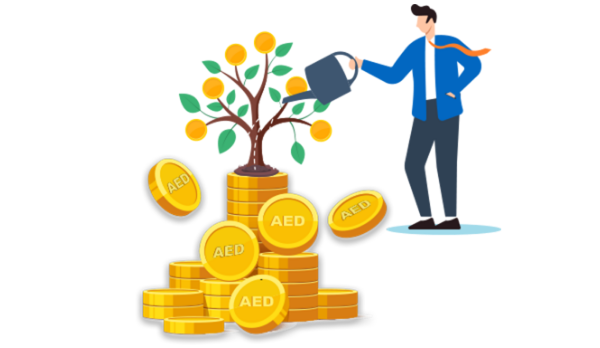NRI Investment in AED: Why It’s a Smarter Choice Over INR
Let’s admit it — even as an NRI in the UAE or any other country, investments in INR back in India feels like the most natural choice. After all, India’s strong economic growth, ample market opportunities, and emotional connection make it a good option.
But what if we told you that the UAE Dirham (AED) could be your next smart move? In fact, with the Dirham’s stability, the UAE’s booming economy and tax-friendly policies, and many other factors, shifting your focus to AED could bring better financial gains and might just be the smarter bet!
Let’s dig deep into the benefits of investing in AED vs INR for NRIs, factors that influence currency stability, and why AED offers a more attractive investment option for long-term growth.
Overview of AED and INR
What is AED? |
What is INR? |
|---|---|
|
|
The Power of Compound Interest in Investment
What is Compound Interest?
Compound interest is the process where the interest earned on your investment is added to the principal amount. This means that interest is earned not only on the initial investment but also on the accumulated interest from previous periods.
Why is Compound Interest Important for Investments?
The concept of compound interest works the same for both AED (United Arab Emirates Dirham) and INR (Indian Rupee).
The key difference between investments in AED and INR is the exchange rate and the performance of the currency over time.
Example for AED Investment
- Principal: AED 100,000
- Annual Interest Rate: 10%
- Compounding Periods: Annually for 10 years
| Year ⏳ |
Starting Value (AED) 📈 |
Interest Earned (10%) 💰 |
Final Value (AED) |
|---|---|---|---|
| 1 | 100,000 | 10,000 | 110,000 |
| 2 | 110,000 | 11,000 | 121,000 |
| 3 | 121,000 | 12,100 | 133,100 |
| 4 | 133,100 | 13,310 | 146,410 |
| 5 | 146,410 | 14,641 | 161,051 |
| 6 | 161,051 | 16,105 | 177,156 |
| 7 | 177,156 | 17,716 | 194,872 |
| 8 | 194,872 | 19,487 | 214,359 |
| 9 | 214,359 | 21,436 | 235,795 |
| 10 | 235,795 | 23,579 | 259,374 |
Note: As the AED is appreciating and INR is depreciating, your investment in AED grows faster in INR terms.
Why Should NRIs Choose AED Over INR for Investment?
Stability of the AED vs Volatility of INR
Economic Growth of the UAE vs India
Low Inflation & High Liquidity
Attractive Investment Environment in the UAE
The UAE Dirham’s peg to the US Dollar ensures its stability, even during periods of global economic uncertainty. This provides investors with a reliable currency for long-term savings and investments.
In contrast, the INR is highly volatile, impacted by factors such as inflation, trade deficits, and interest rates in India. This makes it a less stable option.
The UAE has built a diversified economy driven by sectors such as oil exports, tourism, real estate, and financial services. As the economy continues to grow, the stability of the AED is supported by these factors.
Meanwhile, India’s economic growth, though promising, may face uncertainty due to reliance on certain sectors or more frequent changes in the regulatory environment
The UAE benefits from low inflation, further solidifying the AED’s value. This contrasts with the often higher inflation rates in India, which erode the purchasing power of the INR. Moreover, the AED is highly liquid, meaning it can be easily traded and converted, especially in the forex market.
The UAE’s favourable tax regime, which includes no income tax, capital gains tax, or no inheritance tax, makes the country an attractive destination for NRIs looking to maximise returns. In comparison, India has taxes on savings, interest, and capital gains, reducing the effective returns for investors.
|
Let’s say an NRI invests AED 100,000. Due to the low inflation rate in the UAE (about 2%), the value of their AED investment will not lose significant purchasing power over time. |
|---|
AED Comparison with INR (Indian Rupees)
The Indian Rupee (INR) is a freely traded currency, meaning its value fluctuates based on various factors such as inflation, economic performance, and interest rates. Unlike the AED, which is pegged to the US Dollar, the INR is not fixed to any other currency, resulting in greater volatility in its exchange rate.
For many NRIs (Non-Resident Indians), the combination of currency risk, taxes, and the availability of safer, tax-advantaged investments abroad makes India a less attractive option.
AED vs INR: Exchange Rate:
- In 2015, 1 AED = 16.9 INR
- By 2025, 1 AED = 23.8 INR
This means the Indian Rupee has weakened by over 40% against the AED over the last decade. If you were investing in INR, your returns would not just depend on the stock market performance, but also on the depreciation of the currency, reducing your investment’s value in foreign currency terms.
By choosing a stronger currency like USD or AED for investments, you not only protect your capital from the risks of currency depreciation but also enjoy tax-efficient returns, especially when compared to the complexities of investing in INR-based assets.
AED Comparison with Other Major Currencies
The UAE Dirham (AED) is widely recognised for its stability due to its peg to the US dollar. Here are some factors that need to be considered
As mentioned earlier, the UAE Dirham is pegged to the US Dollar at a fixed rate of 1 USD = 3.6725 AED. This system ensures that the AED’s value stays relatively stable against fluctuations in the global markets. The exchange rate between AED and USD remains predictable and consistent, which is beneficial for long-term investments.
Let’s say you invest AED 100,000. Over time, this investment maintains its value in terms of USD. At the fixed rate, AED 100,000 equals approximately USD 27,226. If you were to exchange AED for USD in the future, you could expect a similar value unless global factors (like the price of oil) lead to drastic changes.
Unlike AED, the Euro is not pegged to any single currency. The exchange rate between AED and EUR can vary based on economic conditions in the Eurozone, inflation rates, and geopolitical events.
The exchange rate between AED and EUR was roughly 1 AED = 0.26 EUR*. If you were to invest AED 100,000, it would be equivalent to EUR 26,320. However, this exchange rate could fluctuate depending on the economic health of the European Union.
For instance, if inflation in the Eurozone rises significantly, the EUR could depreciate. In this case, your investment would be worth less when converted into AED terms.
The Japanese Yen is known for being more volatile than the AED. This is due to Japan’s economic policies, interest rates, and deflationary pressures. While Japan remains one of the world’s largest economies, the JPY’s value can fluctuate greatly.
The exchange rate for AED to JPY was approximately 1 AED = 41.56 JPY*. If you were to invest AED 100,000, it would be worth 4,155,516 JPY. However, if the Japanese government were to lower interest rates or introduce stimulus measures, the JPY could lose value — your investment could be worth less when converted back to AED or other currencies.
The British Pound is subject to political events (such as Brexit) and inflation fluctuations. In contrast, the AED’s peg to the US dollar offers more stability.
The exchange rate between AED and GBP was roughly 1 AED = 0.22 GBP*. If you invest AED 100,000, that would be worth around GBP 21,901. However, factors like changes in UK government policies or economic performance could cause the GBP to either appreciate or depreciate against the AED.
*As of Feb 6, 2025
Conclusion: Investing in AED vs INR
Investing in AED over a long period gives you greater security and higher returns than investing in INR. This grows your wealth more effectively without bringing the risk of value erosion due to depreciation and inflation.
More From Investment
- Recent Articles
- Popular Articles





















